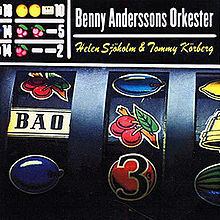Recorded 2007 | Length 44:47 Release date 24 October 2007 | |
 | ||
Released October 24, 2007 (2007-10-24) BAO 3(2007) Story Of A Heart(2009) Awards Grammis Award for Dance Band/Schlager of the Year Similar Benny Anderssons Orkester albums, Folk music albums | ||
BAO 3 is a studio album by Swedish folk group Benny Anderssons Orkester, released on October 24, 2007. It is the group's third studio album and their fourth release in total.
Contents
Album information
Being a typical Benny Anderssons Orkester album, BAO 3 (the title indicates that it's the third BAO album) includes many different musical styles, ranging from Swedish folk music to pop, jazz, classical tunes and Viennese influences. The album is officially credited to "Benny Anderssons Orkester, Helen Sjöholm & Tommy Körberg", indicating that it also includes several tracks with vocals. In fact, compared to its studio predecessor, BAO! in 2004, the number of vocals tracks has increased. Seven out of the 12 tracks on the album are sung by either Helen Sjöholm or Tommy Körberg or as a duet. Körberg can be heard on a BAO studio album for the first time, after already appearing together with the group during their tours and also lending vocals to two tracks on Benny Andersson's two solo albums from the 1980s, Klinga mina klockor and November 1989.
As usual, most of the lyrics were written by Andersson's former ABBA partner Björn Ulvaeus, while all the music was composed by Andersson himself.
BAO 3 was recorded in Sveriges Radios Studio 5 and Atlantis Studio, both in Stockholm, during 2007. Like all Benny Anderssons Orkester albums, it was engineered by Bernard Löhr und subsequently mixed by him and Andersson at Mono Music Studio.
Success and promotion
BAO 3 did not achieve the same success as the group's other two studio albums, which both topped the Swedish Albums Chart and stayed on the chart for 55 weeks. Nevertheless, BAO 3 entered the charts on November 1, reached the top 3 and also managed to collect a Gold disc during its 34-week chart run.
BAO 3 is the first and to date also last album by the group to be released in autumn, namely October. All their other albums were released in late spring and early summer, in May, June or July. And because Benny Anderssons Orkester is also famous for its summer tours, the band and its music is strongly connected with that time of the year. So the album's inability to sell as well as Benny Anderssons Orkester and BAO! could be linked to this rather unusual release date.
Due to Helen Sjöholm giving birth to her first child, Benny Anderssons Orkester did not tour in 2007. Instead, they performed two concerts in Stockholm and Gothenburg to promote the album. Contrary to their summer tours, the venues were not the usual small open-air stages, but rather big concert halls, like the Ericsson Globe in Stockholm, where they played in front of 6,000 people.
Songs and trivia
Two big Svensktoppen hits were released from BAO 3. "Fait Accomplit", with lyrics by Björn Ulvaeus and vocals by Tommy Körberg, entered the radio chart on December 1 and eventually topped the list for 11 weeks in early 2008. In the summer of the same year, the Helen Sjöholm and Tommy Körberg duet "Nu mår jag mycket bättre" became a top 5 hit on Svensktoppen. The lyrics for this song were written by Swedish poet and dramatist Kristina Lugn. By this time, Benny Anderssons Orkester's hit "Du är min man" was still going strong on Svensktoppen, albeit already being four years old, and eventually outliving both tracks by far.
Track listing
All music composed by Benny Andersson.
Personnel
The following musicians appear on BAO 3:
Songs
1Marsch pannkaka3:39
2För dig3:50
3Du frälste mig i sista stund3:57
